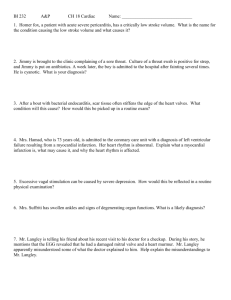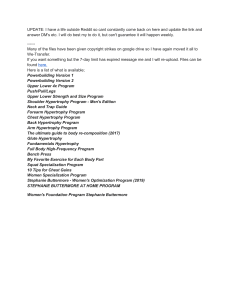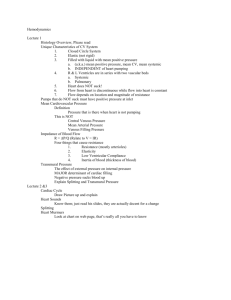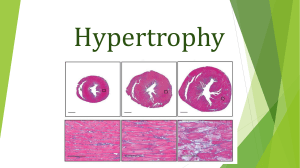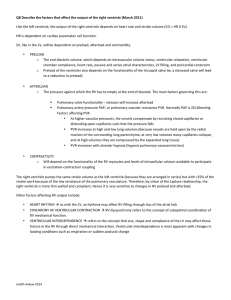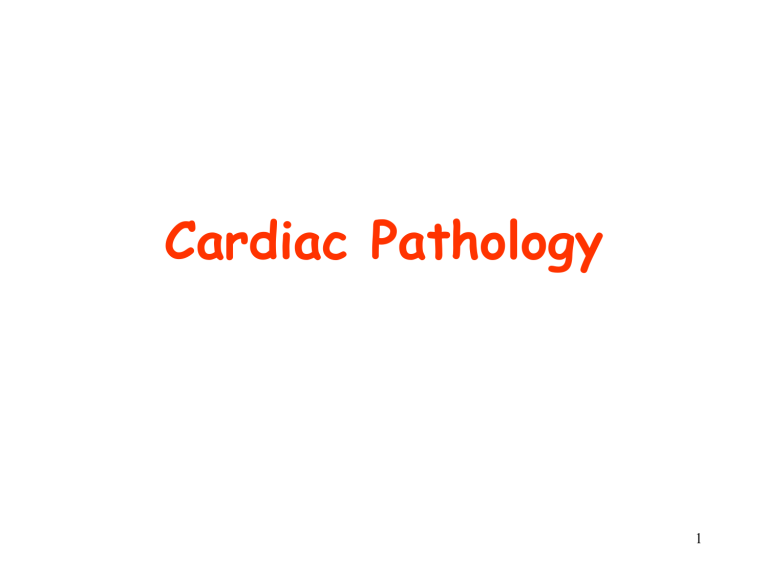
Cardiac Pathology 1 Cardiac Pathology 1. Hypertrophy of ventricles ( hypertensive heart disease) 2. Heart Failure 3. Pulmonary Hypertensive Heart disease ( Cor pulmonale) 4. Ischemic Heart diseases 5. Valvular heart disease 6. Cardiomyopathies 7. Pericardial disease 8. Congenital heart disease 9. Tumors of the heart 2 Normal Heart • Fist size muscular pump • Pumps 6000 lit of blood daily • Perfuses – tissues with nutrients and • Facilitates – removal of waste products. 3 Heart diseases • Are leading cause of morbidity and mortality in developed nations – 750,000 deaths/ year (In US) 4 Normal Heart • Weight – 250 – 300 gm adult female – 300 – 350 gm adult male • Free wall thickness – R ventricle (RV) 0.3-0.5 cm – L ventricle (LV) 1.3-1.5 cm • Cardiomegaly – Increase in weight or size • Due to hypertrophy of myocardium • Due to dilation of chambers. 5 Normal Heart • • • • • Chambers Valves Endocardium** Myocardium Epicardium 6 Normal Heart • 90% of mass of heart is cardiac muscle known as Myocardium • Composed of muscle cells called cardiac myocytes. – Never rest. Contracts ~ once each second – Generate contractile force 7 Cardiac Myocytes • • • • • Have a single nucleus Sarcolemma (cell membrane) Sarcoplamic reticulum ( Ca reservoir) Mitochondria Contractile elements: – k/a myofilaments • Arranged in bundles k/a myofibrils • Myofibrils organized in units k/a Sacomeres • Cardiac myocytres - separated from adjacent cells by Intercalated disks. 8 Nucleus Blood vessel 9 Intercalated discs 10 Conduction System • • • • SA node AV node Bundle of His R & L Bundle Branches – arborize into ventricles 11 Myocardial Hypertrophy (Ventricular hypertrophy) 12 Normal • Heart can increase its output many folds as demand requires. • This is achieved by: 1. increase in the size of the ventricles • ventricular dilatation increased force of contraction Frank Starling law 2. increase in thickness of myofibers • ventricular hypertrophy increased force of contraction. • Failure of compensatory mechanism results in heart failure 13 Two important terms Preload and Afterload 14 Preload • Is the amount of blood in the heart during diastole. • Dependent on venous return to right side of heart. • Increase in preload leads to stretching of cardiac muscle increased force of contraction increased Stroke volume 15 Afterload • Is the resistance against which the ventricle must contract when ejecting blood during systole. 16 What do you see??? 17 Ventricular Hypertrophy • is a compensatory change that the heart undergoes when subjected to an increased workload. – Augments myocyte contractile strength. • Increased workload can occur in association with: 1. Systemic hypertension 2. Valvular stenosis 3. Valvular insufficiency etc. • Ventricular hypertrophy may involve the Left or Right ventricle. 18 Ventricular Hypertrophy • Left ventricular hypertrophy – Two types 1. Concentric 2. Eccentric (dilation and hypertrophy) • Right ventricular hypertrophy – Two types 1. Concentric 2. Eccentric (dilation and hypertrophy) 19 Concentric Ventricular Hypertrophy • Pathogenesis: – Due to contraction against an increased resistance (afterload) • Produces concentric thickening of ventricular wall. • Causes of Concentric LV hypertrophy: – Essential hypertension (MCC)* – Aortic stenosis • Causes of Concentric RV hypertrophy – Pulmonary hypertension* – Pulmonary artery stenosis. 20 Normal Heart Concentric Left ventricular hypertrophy 21 Eccentric ventricular hypertrophy • Pathogenesis: – Due to volume overload (increased preload) • Causes dilatation and hypertrophy (eccentric hypertrophy) of ventricular wall • Causes of Eccentric LV hypertrophy: – Mitral valve or aortic valve regurgitation • Causes of Eccentric RV hypertrophy: – Tricuspid or pulmonary valve regurgitation 22 Hearts, hypertrophied, normal (middle), and dilated 23 Consequences of ventricular hypertrophy 1. Left or right sided heart failure 2. Angina (primarily LVH) 3. S4 heart sound: – Correlates with atrial contraction in late diastole – Caused by blood entering a noncompliant ventricle 24 Congestive Heart Failure 25 Congestive Heart failure • What is Heart failure? – When heart is unable to eject blood delivered to it by the venous system. • Epidemiology: – MC hospital admission diagnosis in elderly patients. • Types of heart failure: 1. Left sided heart failure 2. Right sided heart failure 3. Biventricular heart failure 4. High output heart failure. 26 Left sided heart failure (LHF) • Forward failure: – Left side of heart cannot eject blood into the aorta. – Pathophysiology: • Blood builds up behind the failed left heart: • Increase in left ventricular volume / pressure • Increase in left atrial pressure • Increase in pulmonary venous pressure • Hydrostatic pressure overrides pulmonary capillary oncotic pressure 27 • Pulmonary edema results** Left sided heart failure (LHF) 1. Mechanism: Decreased ventricular contraction – Causes: • Myocardial infarction*** • Myocardial fibrosis, myocarditis, cardiomyopathy. 2. Mechanism: Noncompliant ventricle ( restricted filling) – Causes: • Concentric LVH*** • Infiltration of muscle by amyloid, iron or glycogen ( e.g. Pompe’s disease) 28 Left sided heart failure (LHF) 3. Mechanism: Increased workload – Causes • Increased afterload (resistance) – Systemic hypertension • Increased preload (volume) – Mitral regurgitation 29 Left sided heart failure (LHF) • Gross and microscopic findings: – Lungs are congested and exude a frothy pink transudate (edema) – Alveolar macrophages contain hemosiderin ( heart failure cells) 30 Normal Lung 31 Pulmonary edema Heart failure cells Left sided heart failure (LHF) • Clinical findings: Symptoms outnumber signs – Dyspnea: • Difficulty breathing • Patient cannot take a full inspiration – Pulmonary edema: • Due to increased pulmonary venous hydrostatic pressure • Bibasilar inspiratory crackels • Chest radiographs show congestion in upper lobes 32 Left sided heart failure (LHF) – Left sided S3 heart sound • Caused by blood entering a volume overloaded left ventricle • Intensity of the heart sound increases with expiration • First cardiac finding* in LHF. – Mitral valve regurgitation: • Caused by stretching of the valve ring • Pansystolic murmur at apex • Increases in intensity during expiration 33 Left sided heart failure (LHF) • Paroxysmal nocturnal dyspnea: – Choking sensation at night due to increased venous return to the failed left side of heart – Blood backs up in lungs producing pulmonary edema – Relived by standing or placing a pillow under the head (pillow orthopnea) • These maneuvers increase the effect of gravity on reducing venous return to the heart 34 Left sided heart failure (LHF) • Cough: – Sputum rusty colored – Due to alveolar macrophages phagocytosing RBCs (“heart failure” cells) 35 Left sided heart failure (LHF) • Chest X ray in heart failure: – Prominent congestion of blood in the upper lobes – Perihilar congestion : Batwing configuration – Pleural effusion 36 Normal Lungs Xray 37 Congestive Heart Failure Batwing Pattern 38 Right sided heart failure • Backward failure: – Right side of the heart cannot pump blood from the venous system to the lungs. • Pathophysiology: – Blood accumulates behind failed right heart: – ↑ in right ventricular volume/ pressure – ↑ in right atrial pressure – ↑ in jugular venous pressure – Increase in venous hydrostatic pressure – Hepatomegaly, dependent pitting edema + ascites 39 Right sided heart failure • Pathogenesis: – Decreased contraction ( right ventricular infarction) – Noncompliant right ventricle (e.g. RVH) – Increased afterload (left sided heart failure, MCC) – Increased preload (e.g. tricuspid valve regurgitation) 40 Right sided heart failure • Clinical findings: – Signs outnumber symptoms – Prominence of jugular veins • Due to increased venous hydrostatic pressure – Right sided S3 heart sound : • due to volume overload in the right ventricle • Increases in intensity with inspiration – Tricuspid valve regurgitation • Caused by stretching of valve ring 41 Right sided heart failure • Painful hepatomegaly: – Passive liver congestion due to backup of blood into the central veins (Nutmeg liver) • Dependent pitting edema and ascites – Due to an increase in venous hydrostatic pressure 42 V CVC liver: NutmegLiver 43 Pitting Edema; RHF 44 High-output heart failure • A form of heart failure in which CO is increased compared with values for the normal resting state. • Pathogenesis: – Increase in stroke volume • Hyperthyroidism, increased blood volume – Decrease in blood viscosity • Severe anemia – Vasodilation of peripheral resistance arterioles • Increases venous return to the heart – Causes of vasodilation: »Thiamine deficiency, early phase of 45 endotoxic shock. High-output heart failure • Pathogenesis: – Arteriovenous fistula: • AV communications bypasses the microcirculation • Increases venous return to the heart • Causes of AV fistulas: – Trauma from knife wound (MCC) – Surgical shunt for dialysis – Pagets disease of bone: AV fistulas develop in the bone 46 Thank You! 47
